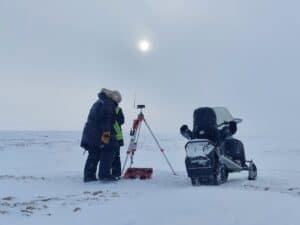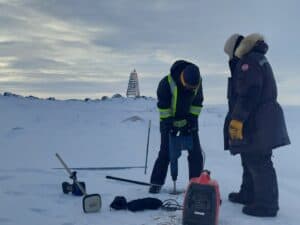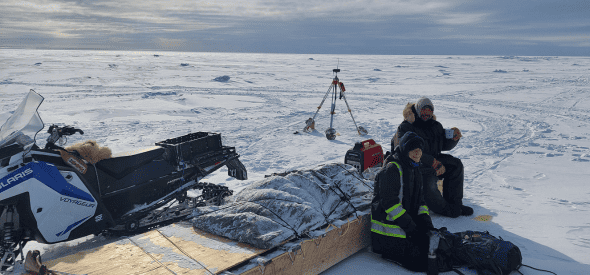Land Surveying in the Arctic
It’s pretty rare that I get in the field these days. We had some work to do near Cambridge Bay related to the Devolution of Nunavut. Devolution is the transfer of federal jurisdiction over Nunavut’s lands, resources and inland waters to the Government of Nunavut. We were doing this work under our majority Inuit owned partner company Kitikmeot Challenger.
Our job was to survey six parcels around Federal shipping navigation aids so that these lands could remain under Federal administration. Our newest CLS, Bailey Simpson was taking responsibility for these surveys, the first of her career. I was along to make sure she got off on the right foot as they were her first and remote as well. I’d like to think I helped a bit but really Bailey didn’t need me up there, better safe than sorry though!
Our guide and wildlife monitor Randy Klengenberg was a huge asset to our work. He was able to navigate through whiteouts with no features to follow on the ocean, we had maps loaded on our phones as backup but we luckily didn’t need them, especially since the cold isn’t great for the battery life. Randy was an A+ part of the team in addition to guiding us through whiteouts, he was able to fix snow machines, give us local knowledge and just an overall great guy to hang out with. It’s such a pleasure to see someone in their element in conditions that most people (myself and Bailey included) would struggle in.

Bailey Simpson and Randy Klengenberg standing on the arctic tundra while conducting a legal survey.
Things went basically to plan, however, when working in the arctic you expect there to be challenges that force you to think on your feet.
On this particular project both Bailey and I had to learn a thing or two on the fly.
We were faced with ionospheric activity which meant that we couldn’t use the same GNSS base stations for multiple parcels. In normal conditions we would have been able to and that was our plan. Instead, we moved base stations between parcels which slows things down but was necessary since the ionospheric activity was high.
It wasn’t just the ionospheric activity that made this job challenging, it was also the rocky and frozen ground that made posting difficult. Luckily this was anticipated and we had brought options including a generator, BIG power drill, a battery drill as a backup, and a sledge for setting rock posts, drilling full length for normal posts. We also had to use muscle as well.

It’s pretty rare that I get in the field these days., but this trip to Cambridge Bay will forever be etched into my mind for years to come.
Written By: Paul Burbidge | President and CEO

